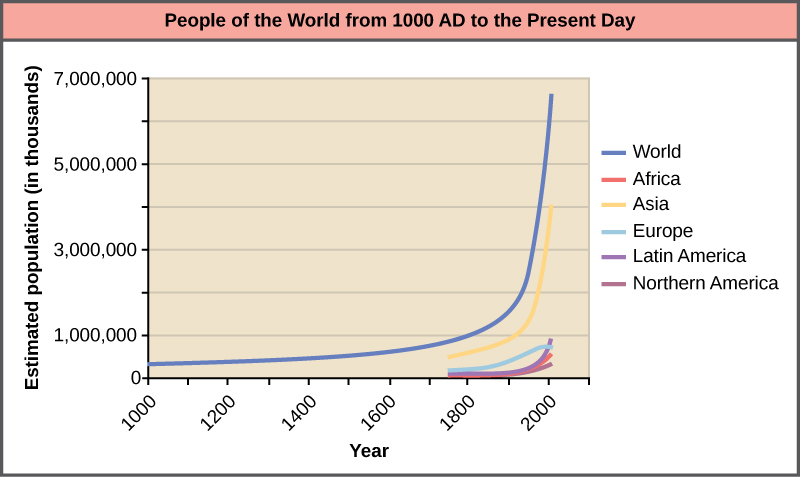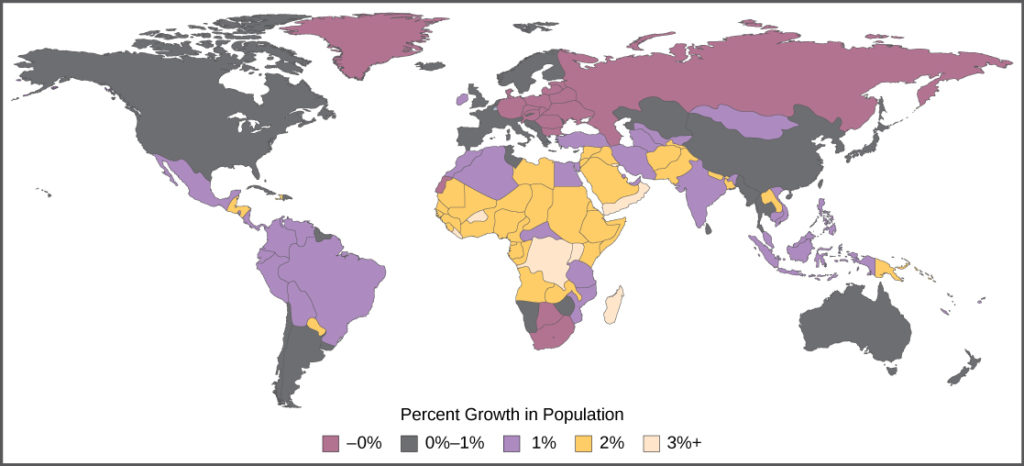If the Human Population Continues to Grow What is a Likely Effect on Land Use
Learning Outcomes
- Discuss how the human population has changed over time
Concepts of animal population dynamics can be applied to human population growth. Humans are not unique in their ability to alter their environment. For example, beaver dams alter the stream environment where they are built. Humans, however, have the ability to alter their environment to increase its carrying capacity sometimes to the detriment of other species (e.g., via artificial selection for crops that have a higher yield). Earth's human population is growing rapidly, to the extent that some worry about the ability of the earth's environment to sustain this population, as long-term exponential growth carries the potential risks of famine, disease, and large-scale death.
Although humans have increased the carrying capacity of their environment, the technologies used to achieve this transformation have caused unprecedented changes to Earth's environment, altering ecosystems to the point where some may be in danger of collapse. The depletion of the ozone layer, erosion due to acid rain, and damage from global climate change are caused by human activities. The ultimate effect of these changes on our carrying capacity is unknown. As some point out, it is likely that the negative effects of increasing carrying capacity will outweigh the positive ones—the world's carrying capacity for human beings might actually decrease.
The human population is currently experiencing exponential growth even though human reproduction is far below its biotic potential (Figure 1). To reach its biotic potential, all females would have to become pregnant every nine months or so during their reproductive years. Also, resources would have to be such that the environment would support such growth. Neither of these two conditions exists. In spite of this fact, human population is still growing exponentially.

Figure 1. Human population growth since 1000 AD is exponential (dark blue line). Notice that while the population in Asia (yellow line), which has many economically underdeveloped countries, is increasing exponentially, the population in Europe (light blue line), where most of the countries are economically developed, is growing much more slowly.
A consequence of exponential human population growth is a reduction in time that it takes to add a particular number of humans to the Earth. Figure 2 shows that 123 years were necessary to add 1 billion humans in 1930, but it only took 24 years to add two billion people between 1975 and 1999. As already discussed, our ability to increase our carrying capacity indefinitely my be limited. Without new technological advances, the human growth rate has been predicted to slow in the coming decades. However, the population will still be increasing and the threat of overpopulation remains.

Figure 2. The time between the addition of each billion human beings to Earth decreases over time. (credit: modification of work by Ryan T. Cragun)
Overcoming Density-Dependent Regulation
Humans are unique in their ability to alter their environment with the conscious purpose of increasing carrying capacity. This ability is a major factor responsible for human population growth and a way of overcoming density-dependent growth regulation. Much of this ability is related to human intelligence, society, and communication. Humans can construct shelter to protect them from the elements and have developed agriculture and domesticated animals to increase their food supplies. In addition, humans use language to communicate this technology to new generations, allowing them to improve upon previous accomplishments.
Other factors in human population growth are migration and public health. Humans originated in Africa, but have since migrated to nearly all inhabitable land on the Earth. Public health, sanitation, and the use of antibiotics and vaccines have decreased the ability of infectious disease to limit human population growth. In the past, diseases such as the bubonic plaque of the fourteenth century killed between 30 and 60 percent of Europe's population and reduced the overall world population by as many as 100 million people. Today, the threat of infectious disease, while not gone, is certainly less severe. According to the Institute for Health Metrics and Evaluation (IHME) in Seattle, global death from infectious disease declined from 15.4 million in 1990 to 10.4 million in 2017. To compare to some of the epidemics of the past, the percentage of the world's population killed between 1993 and 2002 decreased from 0.30 percent of the world's population to 0.14 percent. Thus, infectious disease influence on human population growth is becoming less significant.
Age Structure, Population Growth, and Economic Development
The age structure of a population is an important factor in population dynamics.Age structure is the proportion of a population at different age ranges. Age structure allows better prediction of population growth, plus the ability to associate this growth with the level of economic development in the region. Countries with rapid growth have a pyramidal shape in their age structure diagrams, showing a preponderance of younger individuals, many of whom are of reproductive age or will be soon (Figure 3). This pattern is most often observed in underdeveloped countries where individuals do not live to old age because of less-than-optimal living conditions. Age structures of areas with slow growth, including developed countries such as the United States, still have a pyramidal structure, but with many fewer young and reproductive-aged individuals and a greater proportion of older individuals. Other developed countries, such as Italy, have zero population growth. The age structure of these populations is more conical, with an even greater percentage of middle-aged and older individuals. The actual growth rates in different countries are shown in Figure 4, with the highest rates tending to be in the less economically developed countries of Africa and Asia.
Practice Question

Figure 3. Typical age structure diagrams are shown. The rapid growth diagram narrows to a point, indicating that the number of individuals decreases rapidly with age. In the slow growth model, the number of individuals decreases steadily with age. Stable population diagrams are rounded on the top, showing that the number of individuals per age group decreases gradually, and then increases for the older part of the population.
Age structure diagrams for rapidly growing, slow growing and stable populations are shown in stages 1 through 3. What type of population change do you think stage 4 represents?
Show Answer
Stage 4 represents a population that is decreasing.

Figure 4. The percent growth rate of population in different countries is shown. Notice that the highest growth is occurring in less economically developed countries in Africa and Asia.
Long-Term Consequences of Exponential Human Population Growth
Many dire predictions have been made about the world's population leading to a major crisis called the "population explosion." In the 1968 book The Population Bomb, biologist Dr. Paul R. Ehrlich wrote, "The battle to feed all of humanity is over. In the 1970s hundreds of millions of people will starve to death in spite of any crash programs embarked upon now. At this late date nothing can prevent a substantial increase in the world death rate." While many critics view this statement as an exaggeration, the laws of exponential population growth are still in effect, and unchecked human population growth cannot continue indefinitely.
Several nations have instituted policies aimed at influencing population. Efforts to control population growth led to theone-child policy in China, which is now being phased out. India also implements national and regional populations to encourage family planning. On the other hand, Japan, Spain, Russia, Iran, and other countries have made efforts to increase population growth after birth rates dipped. Such policies are controversial, and the human population continues to grow. At some point the food supply may run out, but the outcomes are difficult to predict. The United Nations estimates that future world population growth may vary from 6 billion (a decrease) to 16 billion people by the year 2100.
Another result of population growth is the endangerment of the natural environment. Many countries have attempted to reduce the human impact on climate change by reducing their emission of the greenhouse gas carbon dioxide. However, these treaties have not been ratified by every country. The role of human activity in causing climate change has become a hotly debated socio-political issue in some countries, including the United States. Thus, we enter the future with considerable uncertainty about our ability to curb human population growth and protect our environment.
Video Review
The world's human population is growing at an exponential rate. Humans have increased the world's carrying capacity through migration, agriculture, medical advances, and communication. The age structure of a population allows us to predict population growth. Unchecked human population growth could have dire long-term effects on our environment.
This video tells us the specifics of why and how human population growth has happened over the past hundred and fifty years or so, and how those specifics relate to ecology.
Try It
Contribute!
Did you have an idea for improving this content? We'd love your input.
Improve this pageLearn More
nankervisidel1939.blogspot.com
Source: https://courses.lumenlearning.com/wm-biology2/chapter/human-population-growth/